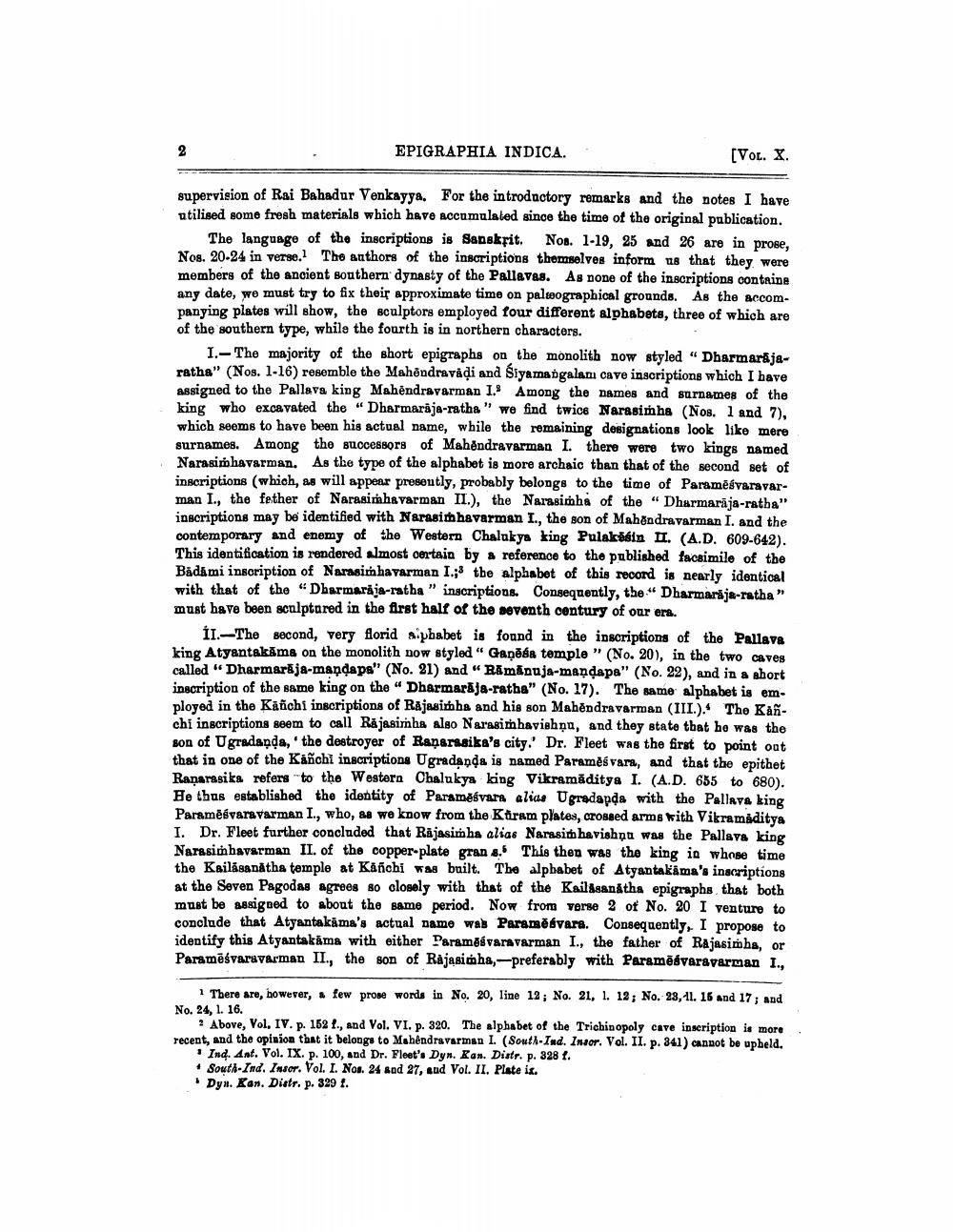________________
EPIGRAPHIA INDICA..
[Vol. X.
supervision of Rai Bahadur Venkayya. For the introductory remarks and the notes I have utilised some fresh materials which have accumulated since the time of the original publication.
The language of the inscriptions is Sanskrit. Nos. 1-19, 25 and 26 are in prose, Nos. 20-24 in verse. The anthors of the inscriptions themselves inform us that they were members of the ancient southern dynasty of the Pallavas. As none of the inscriptions contains any date, we must try to fix their approximate time on palgeographical grounds. As the accompanying plates will show, the sculptors employed four different alphabets, three of which are of the southern type, while the fourth is in northern characters.
I.-The majority of the short epigraphs on the monolith now styled "Dharmarajaraths" (Nos. 1-16) resemble the Mahendraviļi and Siyamangalam cave inscriptions which I have assigned to the Pallava king Mahendravarman 1. Among the names and surnames of the king who excavated the “Dharmaraja-ratha " we find twice Narasimha (Nos. 1 and 7), which seems to have been his actual name, while the remaining designations look like mere surnames. Among the successors of Mahendravarman I. there were two kings named Narasimhavarman. As the type of the alphabet is more archaic than that of the second set of inscriptions (which, as will appear presently, probably belongs to the time of Paramēśvaravarman ... the fether of Narasimhavarman II.), the Narasimha of the “Dharmarāja-ratba" inscriptions may be identified with Narasimhavarman I, the son of Mahendravarman I. and the contemporary and enemy of the Western Chalukya king Pulakásin II. (A.D. 609-642). This identification is rendered almost certain by a reference to the published facsimile of the Bådāmi inscription of Narasimhavarman I.;: the alphabet of this record is nearly identical with that of the "Dharmaraja-ratha " inscriptions. Consequently, the Dharmarija-ratha" must have been sculptared in the first half of the seventh century of our era.
II.-The second, very florid niphabet is found in the inscriptions of the Pallava king Atyantakāms on the monolith now styled " Gaņēša temple " (No. 20), in the two caves called "Dharmarija-manda ps" (No. 21) and “Ramanuja-mandapa" (No. 22), and in a short inscription of the same king on the “Dharmarja-ratha" (No. 17). The same alphabet is emploved in the Kanchi inscriptions of Rajasimha and his son Mahendravarman (III.). The Káñchi inscriptions seem to call Rajasirha algo Narasimhavishņu, and they state that he was the Bon of Ugradanda,' the destroyer of Ranarasika's city.' Dr. Fleet was the first to point out that in one of the Kañchi inscriptions Ugradanda is named Paramėśvara, and that the epithet Ranarasika refers to the Western Chalukya king Vikramaditya I. (A.D. 655 to 680). He thus established the identity of Paraměśvara alias Ugradapda with the Pallava king Paraměsvaravarman I., who, as we know from the Koram plates, crossed arms with Vikramaditya I. Dr. Fleet further concluded that Rājasimha alias Narasimhavishnu was the Pallava king Narasim bavarman II. of the copper-plate gran 8. This then was the king in whose time the Kailasanatha temple at Kanchi was built. The alphabet of Atyantakäma's inscriptions at the Seven Pagodas agrees so closely with that of the Kailasanatha epigraphs that both must be assigned to about the same period. Now from verse 2 of No. 20 I venture to conclude that Atyantakāma's actual name was Paramétvara. Consequently, I propose to identify this Atyantakáma with either Paramėstaravarman I., the father of Rajasimha, or Paramēśvaravarman II., the son of Rajasimha, - preferably with Paramēsvaravarman I..
,
There are, however, a few prose words in No. 20, line 12; No. 21, 1. 12; No. 23, 11. 16 and 17; and No. 24, 1. 16
? Above, Vol. IV. p. 152 1., and Vol. VI. p. 320. The alphabet of the Trichinopoly cave inscription is more recent, and the opinion that it belongs to Mahendravarman I. (South-Ind. Insor. Vol. II. p. 341) cannot be upbeld.
1 Ind. Ant. Vol. IX. p. 100, and Dr. Fleet's Dyn. Kan. Distr. p. 328 1. + South-Ind. Insor. Vol. I. Nos. 24 sad 27, and Vol. II. Plate is.
Dya. Kan. Distr. p. 329.




